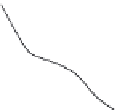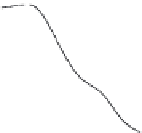Environmental Engineering Reference
In-Depth Information
P
bulb
= 900 W, where the blade settings are defi ned as shown in Fig. 28 at the
blade tips. The rear wind rotor never counter-rotates against the front wind rotor
at the lower wind velocity
V
because not only the rear wind rotor cannot generate
the suffi ciently counter-rotational torque
T
R
corresponding to
T
F
of the front wind
rotor but also the outer armature pulls the inner armature by the magnetic force.
With the increase of the wind velocity, the rear wind rotor with
b
R
larger than 20°
begins to counter-rotate successfully. On the contrary, the rear wind rotor with
b
R
=
10° never change the rotational direction and is in the blowing mode because the
rear blade with the excessively larger angle of attack cannot generate the fruitful
counter-rotational torque due to the fl ow stall on larger scale. Judging from the
counter-rotation expected to this type unit, the rear wind rotor with
b
R
= 20° may
be acceptable within the measured data.
Figure 29 shows the effect of the bulb load on the operating conditions at the blade
setting angles
b
F
=
b
R
= 20°. The load
P
bulb
affects obviously the rotational speed of
Rear Rotor
b
F
Wind direction
b
R
Front Rotor
Figure 28: Blade setting angles.
90
6
P
bulb
b
F
=20deg.
b
R
=20deg.
60
423
1023
60
4
P
bulb
60
423
1023
30
2
0
0
750
600
N
F
300
600
P
bulb
N
F
N
R
P
bulb
60
423
1023
0
450
60
423
1023
-300
300
b
F
=20deg.
b
R
=20deg.
-600
150
N
R
-900
0
0
5
10
15
20
0
5
10
15
20
V
m/s
V
m/s
Figure 29: Effect of the bulb load on the operation conditions.


























































































































































































































































































Search WWH ::

Custom Search